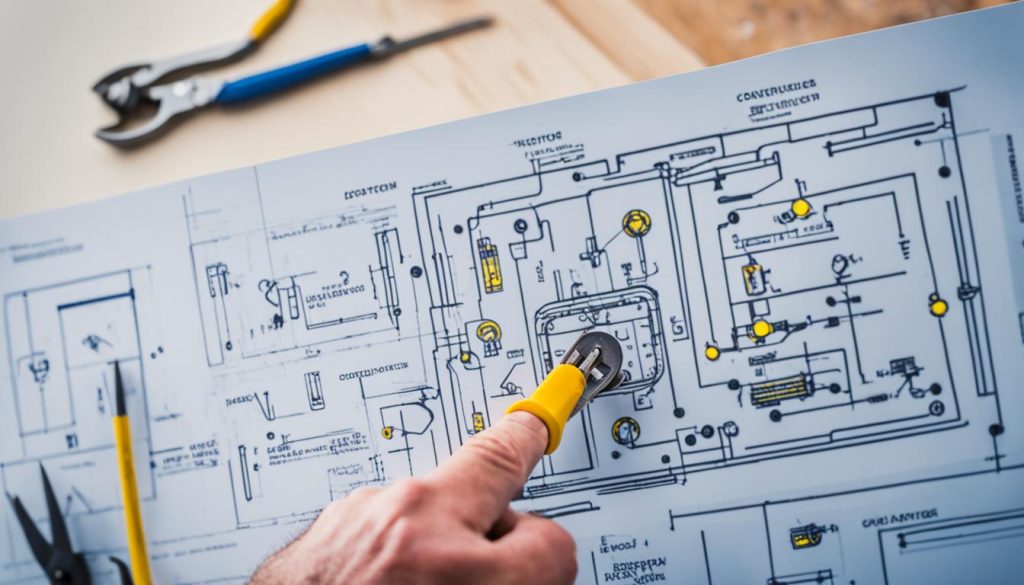Did you know that a staggering 80% of house renovations in Canada are carried out without proper permits? That’s right, the majority of homeowners overlook the essential step of applying for a permit when renovating their homes. This alarming statistic highlights a widespread lack of awareness regarding the importance of building permits and the potential risks associated with undertaking construction projects without them.
If you’re planning a house renovation in Canada, it is crucial to understand the process of applying for a permit and the requirements involved. By obtaining the necessary permits, you can ensure that your renovation meets safety standards, complies with building codes, and avoids potential pitfalls down the line. So, let’s dive into the ultimate guide on how to apply for a permit for your house renovation.
Key Takeaways:
- 80% of house renovations in Canada do not obtain proper permits, posing potential risks and legal consequences.
- Applying for a permit ensures that your renovation meets safety standards and complies with building codes.
- Understanding the application process and requirements is crucial for a smooth and successful renovation.
- Additional permits may be required for electrical, plumbing, and planning aspects of your renovation.
- Compliance with design rules and regulations is necessary to obtain the necessary permits and approvals.
Why are Building Permits Necessary?
Building permits play a crucial role in ensuring the safety and compliance of construction projects with building codes and regulations. These permits are essential to protect homeowners, occupants, and the overall community. By obtaining a building permit, you can ensure that your house renovation is structurally sound and follows the Ontario Building Code in Canada.
Building permits are not just bureaucratic requirements; they are important for safeguarding lives and properties. They help prevent potential hazards and ensure that the construction is carried out in a safe and sustainable manner. Without proper permits, there is a risk of compromising the structural integrity of the building and violating safety standards.
It is also worth noting that building permits are not just limited to major construction projects. Even minor renovations, such as adding a new room or altering the layout, may require a permit. This ensures that the alterations meet the necessary standards and do not pose any risks to inhabitants.
| Importance of Building Permits | Building Code Regulations | Safety Standards for Construction |
|---|---|---|
| 1. Ensures compliance with regulations | 1. Ensures adherence to construction standards | 1. Protects homeowners and occupants |
| 2. Prevents potential hazards | 2. Promotes safe and sustainable construction | 2. Safeguards the community at large |
| 3. Provides legal protection | 3. Maintains consistency in construction practices | 3. Mitigates risks during the construction process |
When is a Building Permit Required?
In most cases, a building permit is required for house renovation projects that involve structural changes, such as adding new structures, making additions, or altering the existing layout of the house. It is also necessary when renovating the basement or making changes that impact the compliance of the building with building regulations. However, minor cosmetic upgrades and finishes usually do not require a permit. It is important to understand the specific requirements and exceptions in your local area to determine if a permit is needed for your house renovation project.
When planning your house renovation, it’s crucial to know the instances when you need a building permit. Structural changes, like constructing a new addition or modifying the layout, often require a permit. This ensures that the construction is done safely and complies with building regulations. Renovating your basement or making changes that affect the building’s compliance also generally require a permit.
On the other hand, minor cosmetic upgrades and finishes, like painting walls or installing new flooring, typically don’t require a permit. These changes are considered cosmetic and do not affect the structural integrity or compliance of the building.
However, it’s important to note that permit requirements may vary depending on your local area and jurisdiction. It’s always best to check with your local municipal authority or building department to understand the specific requirements and exceptions in your area.
If you’re unsure whether your house renovation project requires a permit, it’s always better to err on the side of caution and consult with the appropriate authorities. They can provide guidance and help you determine if a permit is necessary for your specific project.
How to Apply for a Building Permit
Applying for a building permit involves a series of steps to ensure a smooth and successful application process. To help you navigate through the process, I have outlined the necessary steps and documentation required for a building permit application in Canada.
- Step 1: Gather the Required Documentation
The first step in applying for a building permit is to gather all the necessary documentation. This includes completed application forms, project information, and any required authorizations or approvals. Make sure to provide accurate and detailed information to avoid any delays in the application process.
- Step 2: Submit the Application
Once you have gathered all the required documentation, you need to submit your application to the relevant municipal authority. Be sure to include all the forms and supporting documents, along with the appropriate fees. This step is crucial, as missing or incomplete information can lead to delays in the processing of your application.
- Step 3: Application Review
After you have submitted your application, the building department will review it to ensure compliance with building codes and regulations. They may request additional information or documentation to clarify certain aspects of the project. It is important to respond promptly and provide the requested information to avoid any further delays.
- Step 4: Approval and Construction
Once your application is approved, you will receive the building permit. This permit gives you permission to proceed with the construction or renovation project. It is important to prominently display the permit on-site as required by local regulations.
Congratulations! You have successfully applied for a building permit and can now move forward with your construction or renovation project.
| Required Documentation for Building Permit Application |
|---|
| Completed application forms |
| Project information, including plans and specifications |
| Authorization or approvals, if required |
| Appropriate fees |
Additional Permits and Approvals
When it comes to house renovation projects, there are often additional permits and approvals required, depending on the nature of the project and local regulations. These permits ensure that the necessary safety standards are met and that the renovations comply with building codes and land use bylaw specifications. Here are some of the permits you may need to consider:
- Electrical Permit: If your renovation involves any electrical installations or renovations, such as adding new wiring or outlets, you will likely need an electrical permit. This ensures that the electrical work is done safely and meets the necessary standards.
- Plumbing Permit: For any new plumbing installations or alterations, such as adding a new bathroom or relocating existing plumbing fixtures, a plumbing permit is typically required. This ensures that the plumbing work is done properly and meets the required codes.
- Planning Approval: In some cases, planning approval may be necessary if your renovation design or location does not comply with the land use bylaw specifications. This may include projects that impact zoning regulations, setback requirements, or other land use restrictions. Planning approval ensures that your renovation aligns with the local planning guidelines.
It is important to thoroughly understand the specific requirements in your area and obtain the necessary permits and approvals before starting your house renovation project. Failure to do so may result in costly penalties, project delays, or even having to undo completed work. Consulting with local authorities or hiring professionals familiar with the permit application process can help ensure a smooth and compliant renovation journey.

Common Rules for Designing Your Project
When planning your house renovation project, it’s important to be aware of the design rules and regulations that apply. Taking these into consideration will ensure that your project meets the necessary requirements for obtaining permits and approvals. Here are some common rules to keep in mind:
Window and Door Regulations
Windows and doors play a crucial role in the overall design and functionality of your home. When it comes to renovations, there may be specific regulations governing their size, placement, and energy efficiency. For example, bedrooms are required to have proper egress windows for emergency evacuation. It’s essential to familiarize yourself with these regulations and ensure compliance when planning your renovation. This not only ensures the safety and convenience of your home but also helps you avoid any potential setbacks during the permit application process.
Basement Entry Requirements
If you’re considering creating a new entryway to your basement, there are certain requirements you need to adhere to. These may include regulations regarding the location, size, and structural alterations for the new entry. It’s crucial to consult the local building codes and regulations to understand the specifications for basement entries in your area. By ensuring compliance, you can design a functional and aesthetically pleasing basement entry while also meeting the necessary requirements for permits and approvals.
Keeping these design rules in mind when planning your house renovation project will help you create a space that not only meets your needs and preferences but also complies with the regulations set by the authorities. This will streamline the permit application process and ensure that your renovation is carried out smoothly, safely, and legally.

| Design Rules | Description |
|---|---|
| Window and Door Regulations | Ensure compliance with size, placement, and energy efficiency requirements for windows and doors. |
| Basement Entry Requirements | Follow regulations for location, size, and structural alterations when creating a new basement entry. |
Tips for a Smooth Permit Application Process
When it comes to applying for a permit for your house renovation in Canada, following certain tips and best practices can help ensure a smooth and successful application process. Here are some key tips to keep in mind:
1. Gather all the required documentation: Before submitting your application, make sure you have all the necessary documentation in order. This may include completed application forms, project information, plans, and any other supporting documents required by the municipal authority.
2. Prepare a complete application: Take the time to carefully fill out all the application forms and provide accurate and detailed information about your renovation project. Ensure that your application is complete and includes all the required information and plans to avoid any delays or issues.
3. Hire professionals for design and inspection: Depending on the complexity of your renovation project, it may be beneficial to hire professionals such as architects or engineers. They can help you with the design and planning stages, ensuring that your project meets all the necessary building codes and regulations. Additionally, having professionals conduct inspections throughout the construction process can help ensure compliance and address any potential issues early on.
4. Be proactive in responding to requests: During the permit application process, the municipal authority may request additional information or documentation. It is important to be proactive and responsive to these requests, providing the necessary information in a timely manner. This will help keep the process moving smoothly and avoid any unnecessary delays.
By following these tips, you can increase your chances of a successful permit application and a smooth house renovation process. Remember to stay organized, be thorough in your application, and seek professional assistance when needed. Good luck with your renovation project!

Leave a Reply
You must be logged in to post a comment.